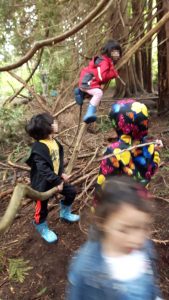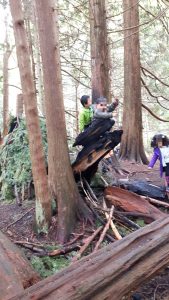May 1 – May 5
Midpoint Meeting Documents:
BMidPoint Checklist
BMidPoint Comments
- MON: PRO-D DAY the greatest takeaway I gained from this day was hearing about the different inquiry projects being conducted throughout the school year. There were several different groups with topics ranging from documentation, mathematics, effective listening and communication with students, and social emotional learning.
- TUE: Story Workshop
- This week I chose to document students recording their stories. My class has been working on creating stories with three or four sequential parts:
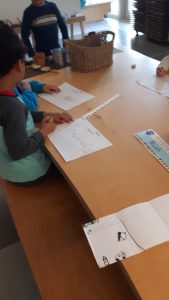
- During recording of their stories I am able to sit down with some students and help them write their stories; lately some students are trying to write on their own (those who I have worked with in the past)
- One girl in particular, who often doesn’t get time to write her story because she draws detailed pictures, sat down with me fairly close to recess to write her story. Once everyone had gone out I asked her if she wanted to go for recess or finish her writing her story, she chose to finish writing her story. This was wonderful for myself as this student is quiet thus, I often struggle to get her to give examples or participate in whole class sharing. I hope that small one-on-one sessions like recording her story can build her confidence and encourage her to share more.
- This week I chose to document students recording their stories. My class has been working on creating stories with three or four sequential parts:
- Book of Letters ‘Zz’
- Reflection & Ways to Improve:
- This week we had a pre-made picture with Zz words and their pictures but we added a few more as a class; this helped in personalizing the lesson as students remembered a character from one of their favorite shows
- Since students do not know many words that start with Zz it was interesting to see some of them realize they knew words that contained Zz’s; some wrote puzzle and pizza, however some were confused that daisy was not spelt with a z
- This week I diversified their book of letters depending on the student (some don’t need a green dot to show them where to start but some do, some also need the green dot on the copy section since they cannot trace – I have noticed some students starting at weird places in this section) I was pleased to see that the students didn’t notice the differences in their books and it did seem to help those who struggle with the fine motor skills required. Additionally one student decided she would rather write all the words (nine in total) than only write and draw at least four which was an acceptable alternative
- Reflection & Ways to Improve:
- WED:Physical & Health Education
- My class has a different teacher that teaches them gym but this was the first week I tried it out. We did the same activities (soccer on one side and gymnastics on the other) that they have been doing in the past and began with a short chat about the importance of stretching. They have been working on listening to their bodies to know when they need to take a rest or drink water thus, stretching fit perfectly with this topic and presented another alternative.
- It is true what they say, gym is a different beast. I do think my first session with them went well, management wise. I feel this is partially due to my efforts to embody the role of their usual gym teacher: I had changed into running shoes, changed into a different set of clothing, and waited at the gym for them.
- I realized that when taking on a role that has previously been filled by a different teacher it is easy to fall into the same routine (for myself and the students) however some changes need to be implemented. An example here is when using a whistle in gym. Although the students know the whistle means change stations or stop they still looked at their usual teacher before looking to me.
- THUR: Author Study: Nicholas Oldland
- Afternoon Earthquake Drill
- I ran this drill and had students practice several times prior to the actual drill. I gave the students time to ask questions about the drill but quickly ended the period when questions began to change topic. To distract the students we read a few poems by Shel Silverstein from Don’t Bump the Glump. These poems serve as a good distraction due to the art and the nonsensical words.
- The students moved quickly under their tables, like we practiced, and were quiet. When I began to start counting, once the ‘shaking’ stopped, several students began to count with me. Although this isn’t supposed to be the case is seemed to help some students to participate in something familiar while something more foreign was occurring around them.
- During this drill it became clear that the teacher-student relationship is very important during these drills/possible emergency situations. Students need to trust that you as a teacher can ensure their safety and myself as a teacher needs to be able to trust that my students will respond accordingly or immediately react when informed of what to do. I can happily say I feel I have built this trust with my students.
- FRI: Cooking
- The three TC’s in our community ran the cooking session we had today. We planned in advance by doing the math to find out how many/much of each ingredient we would need in order to feed the students and volunteers (parents). We also gathered the materials (bowls, measuring spoons, measuring cups, mixing spoons, and so on) the day before and prepped the morning of.
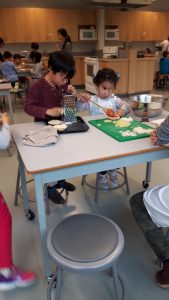

- It was very fun to run a different type of education with the students and to see the interactions with parents. Our prep had paid off as we had little waste and the cost when divided among the students was only a dollar each.
- A newer focus of the cooking activities is to ensure all of the dishes are washed, the table has been set, and everyone waits to eat until everyone is ready. This is important to have students focus on team work and to celebrate their success as a group.
- Nature School
- Today was the first day I was leading nature school. I mapped out my route earlier in the day with the plan of students returning to their play place from the beginning of the year.
- I really enjoy watching the students interact with nature whether it is exploring and investigating that nature or integrating it into their play.
-
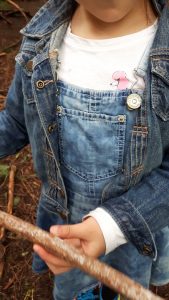
A student investigating the color of the bark, there was white fungus growing on it.

Students enjoy climbing this tree and using it during play, this time it was a fort.
- On this particular session I noticed that while playing in nature students work harder to resolve their conflicts with other students. For example while observing several boys playing on a large stump one of them was pushed and fell down. He quickly stood back up and said “hey NAME, why would you push me!?” to which his friend responded “I didn’t mean to, sorry” and that was the end of this conflict. Another situation I saw was a boy who picked up a stick and another said that was his stick. After negotiating for several minutes the first boy picked up a different stick claiming it was better anyway. I have seen several situations similar to these in the classroom where either myself or another adult are almost instantly informed of the situation for it to be resolved. During the second conflict one of the students even said “I had it first” which I have been told plenty of times when students seek my help to resolve their conflicts. It was wonderful to see that nature school can create a greater environment which motivates students to resolve/avoid their own problems rather than having to stop their play.
